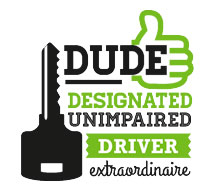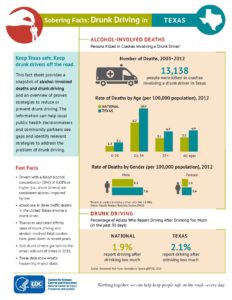
Every day, 28 people in the United States die in motor vehicle crashes that involve an alcohol-impaired driver. This amounts to one death every 53 minutes1.
The problem of driving under the influence:
- Texas continues to lead the nation in alcohol impaired driving fatalities1.
- In 2014, 3 out of every 10 (30%) drivers with BAC levels of .08% or higher were between 21 and 24 years of age, the largest percent of any age group2.
- Of all individuals, 18to 21 year olds continue to have the highest number of alcohol involved deaths which has not changed since before 20101.
- The rate of alcohol impairment among drivers involved in fatal crashes in 2014 was almost 4 times higher at night than during the day (34% versus 9%), this has remained constant over the past 10 years1,7.
- For college aged individuals, the highest number of fatalities occurred between 2:00 a.m. and 2:59 a.m.. Among crashes that involved alcohol – a whopping 33% occurred between 12 am – 3 am3.
- In 2014, 16 percent of all drivers involved in fatal crashes during the week were alcohol-impaired, compared to 29 percent on weekends1.

Binge Drinking and Heavy Drinking:
- College students on average report higher levels of drinking than their non-college peers2.
- In the most recent National Survey on Drug Use and Health, 38% of college students ages 18–22 engaged in binge drinking (5 or more drinks on an occasion) in the past month compared with 33.5% of their non-college peers2.
- In addition, 12.2% of college students ages 18–22 engaged in heavy drinking (5 or more drinks on an occasion) in the past month compared with 9.5% of their non-college peers2.
What to do about driving under the influence of alcohol:
- Driving after even one drink is just not worth it.Ride with a sober friend, ask someone else to drive or call a parent or older sibling. Be sure to always keep a DUDE around: DESIGNATED UNIMPAIRED DRIVER EXTRAORDINAIRE.
- A good rule of thumb to know if someone has had to much is to count their drinks NOT their physical cues of intoxication. Research has shown that most people don’t exhibit signs of intoxication until over .15 (source).
- Food, coffee or exercise will notreduce the amount of alcohol in your system. Only time decreases the effects of alcohol.
- Don’t believe you can “fool” a police officer. They are trained to look for tale-tell signs of a driver who is under the influence.
- If a friend has been drinking and is about to drive, speak up. Offer to drive, take the keys or call a parent. An angry friend is better than a dead friend.
- Neverget in the car with a driver who has been drinking. Everyone reacts to alcohol differently. If you know a friend has been drinking, assume they are unable to drive.
Additional consequences of driving under the influence:
- Zero tolerance law makes it illegal per se (in and of itself) for persons under the age of 21 to drive with any measurable amount of alcohol in their blood5.
- Violators of underage drinking laws often face a trip to jail, the loss of their driver’s license, and dozens of other unanticipated expenses including attorney fees, court costs, and other fines5.
- A DUI conviction follows you, so there is the added embarrassment, humiliation, and potential loss and consequence related to academic eligibility, college acceptance, scholarship awards, and more5.
- Increased efforts by local law enforcement make the chances of getting caught even greater.
- The Texas Department of Transportation conducted a study which found that a first time offender could expect to pay between $5,000and $24,000 for DWI arrest and conviction.
References:
- Department of Transportation (US), National Highway Traffic Safety Administration (NHTSA). Traffic Safety Facts 2014 data: alcohol-impaired driving. Washington, DC: NHTSA; 2015 [cited 2016 Feb 5]. Available at URL: http://www-nrd.nhtsa.dot.gov/Pubs/812231.pdf
- Substance Abuse and Mental Health Services Administration (SAMHSA). 2014 National Survey on Drug Use and Health (NSDUH). Table 6.88B—Alcohol use in the past month among persons aged 18 to 22, by college enrollment status and demographic characteristics: Percentages, 2013 and 2014. Available at:http://www.samhsa.gov/data/sites/default/files/NSDUH-DetTabs2014/NSDUH-DetTabs2014.htm#tab6-88b
- Fatality Analysis Reporting System, 2014.
- Center for Disease Control and Prevention
- Hingson RW, Zha W, Weitzman ER. Magnitude of and trends in alcohol-related mortality and morbidity among U.S. college students ages 18-24, 1998-2005. Journal of Studies on Alcohol and Drugs, July(Suppl 16): 12-20, 2009.
- http://www.collegedrinkingprevention.gov/
- National Highway Traffic Safety Administration